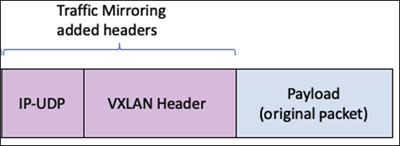Understanding traffic mirror packet format
Mirrored traffic is encapsulated with a VXLAN header. All appliances that receive traffic directly with this feature should be able parse a VXLAN-encapsulated packet, as shown in the following example:

For more information about the VXLAN protocol, see RFC 7348
The following fields apply to Traffic Mirroring:
-
VXLAN ID — The virtual network ID that you can assign to a traffic mirror session. If you do not assign a value, we assign a random value that is unique to all sessions in the account.
-
Source IP address — The primary IP address of the source network interface.
-
Source port — The port is determined by a 5-tuple hash of the original L2 packet, for ICMP, TCP, and UDP flows. For other flows, the port is determined by a 3-tuple hash of the original L2 packet.
-
Destination IP address — The primary IP address of the appliance, Gateway Load Balancer endpoint, or Network Load Balancer (when the appliance is deployed behind one).
-
Destination port — The port is 4789, which is the well known port for VXLAN.
Appliances that received mirrored traffic through a Gateway Load Balancer should be able to parse both outer GENEVE encapsulation (from Gateway Load Balancer) and an inner VXLAN encapsulation (from VPC Traffic Mirroring) to retrieve the original L3 packet. The following shows an example:
